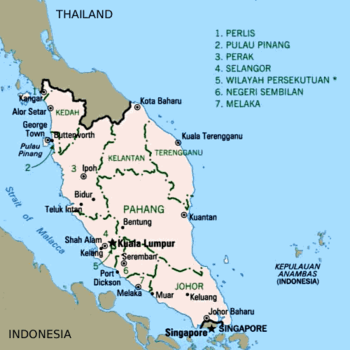Peninsular Malaysia
Coordinates: 4°0′N 102°30′E / 4.000°N 102.500°E

Peninsular Malaysia (Malay: Semenanjung Malaysia), also known as West Malaysia (formerly Malaya), is the part of Malaysia which lies on the Malay Peninsula and surrounding islands. Its area is 130,590 square kilometres (50,420 sq mi). It shares a land border with Thailand in the north. To the south is the island of Singapore.[1]
Across the Strait of Malacca to the west lies the Sumatra Island (Indonesia) and across the South China Sea to the east lies the Natuna Islands (Indonesia). Peninsular Malaysia accounts for the majority (roughly 80%) of Malaysia's population and economy; as of 2015 its population is roughly 25 million.
States and territories
Peninsular Malaysia consists of the following 11 states and two federal territories (starting from the North going to the South):[2]
- Northern Region: Perlis, Kedah, Penang, Perak
- East Coast Region: Kelantan, Terengganu, Pahang
- Central Region: Selangor, Negeri Sembilan, federal territories of Kuala Lumpur and Putrajaya
- Southern Region: Melaka, Johor
Etymology

The name "Malaya" is derived from the name of a river of a similar name found in Sumatra.[3] In 1963, the name Malaysia was adopted by the new federation uniting the Federation of Malaya, North Borneo, Sarawak and Singapore. At the time, the Philippines had also contemplated adopting the name.[4]
Peninsular Malaysia is also known as West Malaysia (Malaysia Barat) or Malaya (Tanah Melayu).[5][6] The term "Peninsular Malaysia" is used more often than "West Malaysia" to avoid the idea that West and East Malaysia are separate countries, and as "Malaya" obsolete due to its connotations of the British colonial era.
Nonetheless, all three terms are correct, and the older term "Malaya" can still be found in many institutional titles, e.g. the High Court of Malaya, the University of Malaya, Malayan Railway, etc., as well as in legal contexts in the phrase the "States of Malaya" (Negeri-negeri Tanah Melayu), which should not be confused with the Malay states. In current everyday usage the word Malaya is almost always used jocularly, e.g. "Gempar satu Malaya!" which roughly means "(This news) shakes the whole of Malaya!"[7]
Singapore
The term Malaya generally included Singapore until 1946, when Singapore was excluded from the formation of Malayan Union. In Singapore law, "Malaya" includes Singapore, whereas the term "States of Malaya" does not.
Demographics
The majority of people on Peninsular Malaysia are ethnic Malays, predominantly Muslim.[8] Large Chinese and Indian populations exist. The Orang Asli are the indigenous people of Peninsular Malaysia; they numbered around 140,000 and mostly lived in inland parts of the region.
Other features

East Coast and West Coast
The term East Coast is particularly used in Malaysia to describe the following states in Peninsular Malaysia facing the South China Sea:
The term West Coast refers informally to a collection of states in Peninsular Malaysia situated towards the western coast generally facing the Strait of Malacca, as opposed to the East Coast. Unlike the East Coast, the West Coast is partitioned further into three regions (as seen in #States and territories), including:
- The Northern Region: Perlis, Kedah, Penang and Perak.
- The Central Region: Selangor and the federal territories of Kuala Lumpur and Putrajaya.
- The Southern Region: Negeri Sembilan, Melaka and Johor
Even though Johor has a coastline facing the South China Sea, it is not generally regarded as an East Coast state.
West and East Malaysia
The distinction between West and East Malaysia (Sabah and Sarawak) is significant beyond the sphere of geography, because as well as they were separate regions before the formation of The Federation of Malaysia, thus having a different court structure, and the eastern states have more autonomy than the original States of Malaya, for example, autonomy in immigration. These rights were granted as part of Sarawak's 18-point agreement and Sabah's 20-point agreement with Federation of Malaya in forming the Federation of Malaysia.
See also
References
- ↑ "Peninsular Malaysia".
- ↑ "Malaysia Regions".
- ↑ Abdul Rashid, Melebek; Amat Juhari, Moain (2006), Sejarah Bahasa Melayu ("History of the Malay Language"), Utusan Publications & Distributors, pp. 9–10, ISBN 967-61-1809-5
- ↑ Sakai, Minako (2009). Cao, Elizabeth; Morrell, eds. Regional Minorities and Development in Asia (PDF). Routledge. p. 124. ISBN 978-0-415-55130-4.
- ↑ Mohamed Anwar Omar Din (2012). "Legitimacy of the Malays as the Sons of the Soil". Canadian Center of Science and Education. pp. 80–81. ISSN 1911-2025.
- ↑ Reid, Anthony (2010). Imperial alchemy : nationalism and political identity in Southeast Asia. Cambridge University Press. p. 95. ISBN 978-0-521-87237-9.
- ↑ Hikmah, kelaziman jodoh tidak kesampaian
- ↑ "Some aspects of Malay-Muslim Ethnicity in Peninsular Malaysia". June 1981. JSTOR 25797648.
External links
-
 Peninsular Malaysia travel guide from Wikivoyage
Peninsular Malaysia travel guide from Wikivoyage
